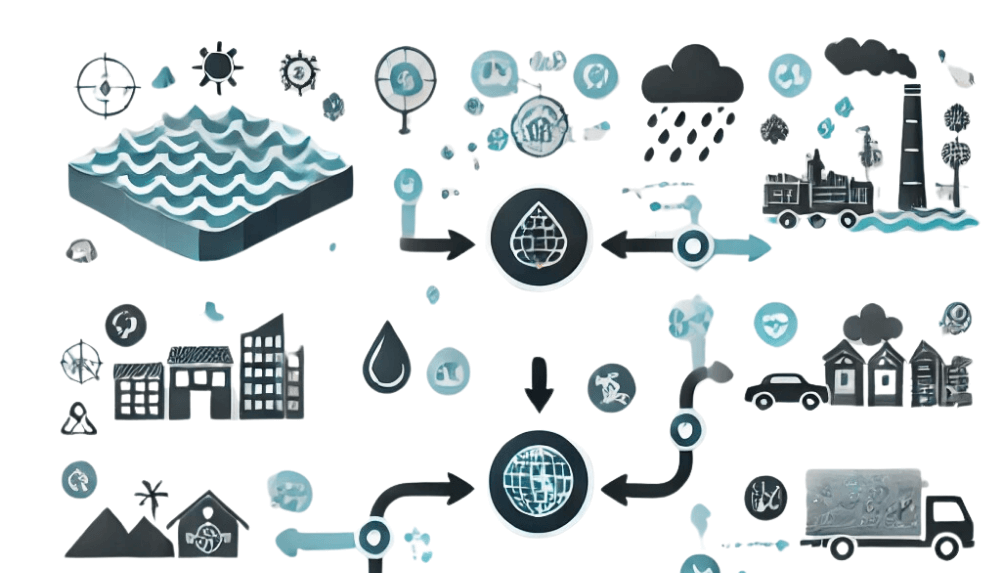The essence of climate change mitigation is therefore the implementation of measures to mitigate or slow down the progress of climate change, primarily by reducing greenhouse gas emissions. Current climate change is directly linked to the amount of greenhouse gases emitted into the atmosphere. Mitigation measures therefore focus directly on reducing the amount of greenhouse gases we emit into the atmosphere. In particular, the amount of CO2 is considered the most significant.
In contrast to adaptation measures, which have a direct effect mainly at the point of their implementation, mitigation measures have a global effect. We cannot expect, for example, to prevent the effects of climate change in the vicinity of a coal-fired power station by closing it. It will only reduce its contribution to global change across the planet. This often gives the impression that we cannot do anything on our own and that someone else must do the mitigation for us. But in the end, it is every single action that counts, and even small reductions can have a big effect if implemented en masse.
This is where the important role of local government comes in. General strategies and plans can be successfully developed at the national level. However, it would be unrealistic to implement a multitude of small measures at the level of everyday energy use across the country in the hands of the state. On the other hand, individual commitment, important as it is, cannot be demanded of everyone. The motivations and capacities of individuals vary widely. Local governments stand halfway between these extremes. They have sufficient organisational structure and support from above to be able to implement costly measures, while at the same time being close enough to residents to be able to engage in their daily lives in a variety of ways.
From the city’s point of view, mitigation measures have another indisputable advantage: they bring substantial savings in operating costs. For the price of a one-off investment, the energy consumed is saved, which, in addition to reducing CO2 emissions, translates into long-term savings for municipal (and private) budgets. They also increase the energy self-sufficiency of the city, which can have a positive impact on its economic level and mitigate the impact of emergencies that would affect the energy supply.
Mitigation measures
In practice, mitigation is divided into two main strands: energy savings and switching to renewable energy sources.
Energy savings can be achieved by reducing the energy consumption of buildings (by insulating the building envelope, replacing windows, optimising or replacing the heat or cooling source, etc.) or by upgrading technologies (public lighting, etc.). Cities typically have several buildings with different energy demands, different operating regimes and different histories of repair, renovation and retrofitting. There is therefore a need for an efficient building management system that allows the control and comparison of requirements and individual buildings in a clear way. Energy monitoring systems are suitable for this purpose, ideally using an automated energy consumption data collection system. This system can be further extended to include the possibility of actively managing energy production/consumption.
In addition to the traditional mechanisms, new ways of financing energy-saving measures are available, such as the EPC method (Energy Performance Contracting, translated into English as energy services with guarantee). These work by having the energy company supply the technology and guarantee the size of the savings achieved on the part of the city. The investor (in this case the city) then pays for the delivered technology for an agreed period out of the money saved. Thus, the city has a minimum amount of savings contractually guaranteed, while the investor is motivated to deploy a truly cost-effective solution because it allows him to maximize his profit. With the proviso that the profit from savings achieved above the specified minimum can be split between the city and the provider as agreed.
Some energy consumed can be replaced by self-generation from renewable sources, which have a significantly lower carbon footprint compared to the national energy mix. This could be by placing photovoltaic panels on the roofs of buildings owned by the city or its constituent organisations. The electricity generated will primarily be used to cover the consumption of these buildings. Any surplus electricity generated can be utilised using a virtual battery or a suitably sized battery storage. The price of electricity from photovoltaics is currently very favourable. Since the so-called solar boom in 2010, when most installations were built in the country, their price has dropped by 90%. In contrast, the market price of electricity is rising. The return on investment in RES is thus very favourable. After the rapid development of the energy market during the winter of 2021/2022, in some cases, it is possible to realistically approach a return on investment in the previously unthinkable 3-4 years when acquiring renewable energy sources.
From the city’s point of view, mitigation measures have another undeniable advantage: they bring substantial savings in operating costs. For the price of a one-off investment, energy consumption is saved, which, in addition to reducing the amount of CO2 emitted, translates into long-term savings in municipal (and private) budgets. They also increase the energy self-sufficiency of the city, which can have a positive impact on its economic level and mitigate the impact of emergencies that would affect the energy supply.
Community energy
In the future, there is also the alternative of using the energy produced in the context of community energy. This consists of sharing energy production and consumption between several facilities or between different facility operators. This offers better possibilities for optimising and using the energy produced than using RES within a single building. It is not necessary to supply the produced energy to the grid under unfavourable conditions or to take more energy from the grid. Community energy is currently not yet fully possible under Czech law. However, the new Energy Act currently under preparation, or the amendment to the Energy Act and other regulations, will bring about a change in this respect (these changes are now expected by 2024). In the new legislation, the emphasis will be on the use of RES and the various possibilities of their application. Due to the administrative and technical complexity, it is advisable to prepare projects that use community energy already now, although the final form of the new legislation is not yet known.
Of course, increasing the share of production from own RES has its limits. Part of the energy will always have to be supplied from the grid (building complete energy self-sufficiency at the moment does not give
from an economic point of view and also from the point of view of ensuring the security and stability of energy supply). However, the environmental aspect should also be taken into account when purchasing electricity. For example, by switching to a supplier that uses RES as a priority, the associated carbon footprint can be reduced by up to 80%. According to existing experience, the price of green electricity supplied in this way may not be higher than the market average.
Transport is another area where significant energy or fuel savings can be achieved with an impact on CO2 production. The basis for effective energy-saving measures is to prioritise public transport over individual car transport wherever it can offer a sufficiently attractive alternative. The operation of fast, efficient and convenient public transport, together with a network of long-distance connections to meet the demand for daily commuting, is therefore essential. At the same time, the fleet needs to be continuously modernised and new, more efficient technologies introduced.
An important characteristic of a modern transport system is the close interdependence and complementarity of different modes of transport. The user thus always chooses a specific means of transport for the journey and has a wide range of options at his disposal. Rail and bus transport, taxi service and car sharing with individual car transport complement each other. In addition, cycling, bike and scooter sharing systems, are complemented by pedestrian transport. Passengers can use different modes of transport for different parts of their journey. For example, they can drive from their home to the nearest train station, park there and continue by train. This is why the creation of interconnections in the form of convenient transfer terminals, P+R or K+R car parks or lockable cycle boxes is essential in a modern transport system.
At the same time, it is necessary to ensure a gradual transition to low- and zero-emission vehicles. This concerns both the public transport sector, where the city can directly influence the vehicle fleet in public transport and its municipal organisations, and private transport. Here, the city should primarily play a role in ensuring the development of the infrastructure that new forms of transport, led by electromobility, will require.
Initial targets for mitigation
- The climate and energy targets of the Czech Republic are part of several strategic documents. In the area of mitigation, this is the Climate Protection Policy in the Czech Republic (focusing on the period 2017 to 2030, with a view to 2050), which sets a target of reducing 80% of greenhouse gas emissions by 2050. By 2030, the Czech Republic aims to reduce emissions by 43% in the ETS (not applicable to municipalities) and by 14% in other sectors (including municipalities, primarily transport, buildings, agriculture, waste management, etc.), all compared to the situation in 2005.
- Existing EU-level targets (the so-called EU Climate Law): at least a 55% reduction in emissions by 2030 compared to 1990, an increase in the share of renewables to 32% and a 32.5% increase in energy efficiency. In 2021, the EU is expected to commit to achieving climate neutrality by 2050. All this is to be done in line to keep the rate of warming to 1.5 °C by 2050.
- During 2021, a comprehensive review of EU climate and energy legislation continues, which will have direct implications for national legislation on renewable energy and energy efficiency. This process culminated in June 2021 with the adoption by the European Parliament of the so-called European Climate Legislative Framework, which includes the aforementioned legally binding targets to reduce CO2 emissions by 55% by 2030 and achieve climate neutrality by 2050.




















